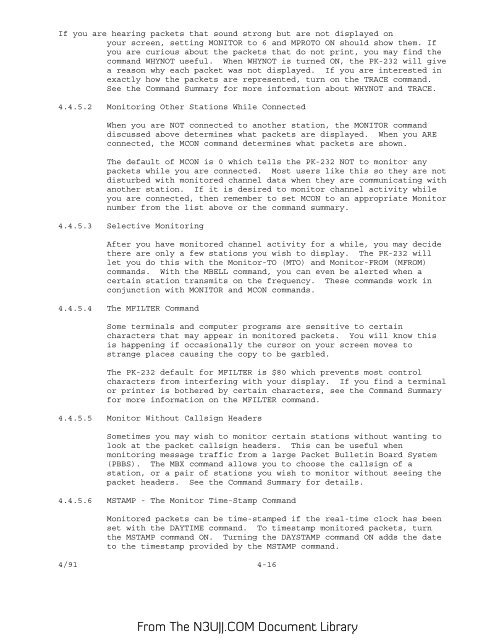Create successful ePaper yourself
Turn your PDF publications into a flip-book with our unique Google optimized e-Paper software.
If you are hearing packets that sound strong but are not displayed on<br />
your screen, setting MONITOR to 6 and MPROTO ON should show them. If<br />
you are curious about the packets that do not print, you may find the<br />
command WHYNOT useful. When WHYNOT is turned ON, the <strong>PK</strong>-<strong>232</strong> will give<br />
a reason why each packet was not displayed. If you are interested in<br />
exactly how the packets are represented, turn on the TRACE command.<br />
See the Command Summary for more information about WHYNOT and TRACE.<br />
4.4.5.2 Monitoring Other Stations While Connected<br />
When you are NOT connected to another station, the MONITOR command<br />
discussed above determines what packets are displayed. When you ARE<br />
connected, the MCON command determines what packets are shown.<br />
The default of MCON is 0 which tells the <strong>PK</strong>-<strong>232</strong> NOT to monitor any<br />
packets while you are connected. Most users like this so they are not<br />
disturbed with monitored channel data when they are communicating with<br />
another station. If it is desired to monitor channel activity while<br />
you are connected, then remember to set MCON to an appropriate Monitor<br />
number from the list above or the command summary.<br />
4.4.5.3 Selective Monitoring<br />
After you have monitored channel activity for a while, you may decide<br />
there are only a few stations you wish to display. The <strong>PK</strong>-<strong>232</strong> will<br />
let you do this with the Monitor-TO (MTO) and Monitor-FROM (MFROM)<br />
commands. With the MBELL command, you can even be alerted when a<br />
certain station transmits on the frequency. These commands work in<br />
conjunction with MONITOR and MCON commands.<br />
4.4.5.4 The MFILTER Command<br />
Some terminals and computer programs are sensitive to certain<br />
characters that may appear in monitored packets. You will know this<br />
is happening if occasionally the cursor on your screen moves to<br />
strange places causing the copy to be garbled.<br />
The <strong>PK</strong>-<strong>232</strong> default for MFILTER is $80 which prevents most control<br />
characters from interfering with your display. If you find a terminal<br />
or printer is bothered by certain characters, see the Command Summary<br />
for more information on the MFILTER command.<br />
4.4.5.5 Monitor Without Callsign Headers<br />
Sometimes you may wish to monitor certain stations without wanting to<br />
look at the packet callsign headers. This can be useful when<br />
monitoring message traffic from a large Packet Bulletin Board System<br />
(PBBS). The <strong>MBX</strong> command allows you to choose the callsign of a<br />
station, or a pair of stations you wish to monitor without seeing the<br />
packet headers. See the Command Summary for details.<br />
4.4.5.6 MSTAMP - The Monitor Time-Stamp Command<br />
Monitored packets can be time-stamped if the real-time clock has been<br />
set with the DAYTIME command. To timestamp monitored packets, turn<br />
the MSTAMP command ON. Turning the DAYSTAMP command ON adds the date<br />
to the timestamp provided by the MSTAMP command.<br />
4/91 4-16<br />
From The <strong>N3UJJ</strong>.COM Document Library
















